It’s a tasty jungle out there, and our dogs don’t always know what’s good for them – or even edible! You’re probably aware of foods that are poisonous to dogs around the home, such as grapes and chocolate – but what should your pooch steer clear of when you’re out and about? We list some of the most common things dogs can’t eat.
Autumn walks with your dog are full of intriguing sights, sounds and scents – but not everything dogs come across will be good for them if eaten. Brushing up on your recall training will help you call them back if they get carried away.
Park and garden plants that are poisonous to dogs
A number of cultivated plants are toxic to dogs – including some that are grown for autumn colour, such as amaryllis (especially the bulbs) and hydrangeas.
Many flowering bulbs are toxic to dogs. You may already know that daffodils and tulips are poisonous to dogs, and the same is also true of autumn-flowering crocuses. Beware of your dog digging up bulbs that have been newly planted in autumn for next spring.
Azalea and rhododendron bushes can cause nausea, vomiting, breathing difficulties and coma if ingested by dogs. Grape and wisteria vines should also be avoided, and ivy can also be harmful to dogs if eaten in large quantities.
 Amarylis
Amarylis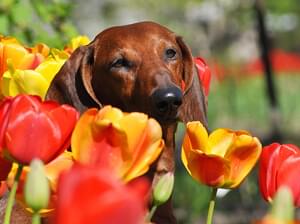 Tulips
TulipsTrees that are toxic to dogs
Care should be taken with dogs around two of autumn’s best-loved trees, the oak and horse chestnut. The acorns and conkers they produce (or their leaves) could make your dog very ill if he chomps down enough of them. However, severe cases of poisoning are rare.
Beechnuts, which also fall in autumn, can cause bad stomach upsets. And if swallowed whole, any of these nuts could also cause throat blockages.
One of the most toxic trees is the yew, an evergreen often found in churchyards. In extreme cases, yew needles, bark and red berries can be deadly to both dogs and humans.
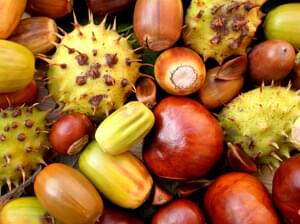 Acorns and Conkers
Acorns and ConkersAutumn berries dogs shouldn’t eat
Both elderberries and holly berries can cause stomach upsets in dogs. But the most dangerous berry-bearing plants are deadly nightshade, with its shiny black berries; cuckoo pint, aka lords-and-ladies (which produces spikes of orange-red berries), and mistletoe. All are typically found in woodland.
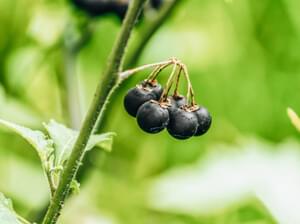 Deadly Nightshade
Deadly NightshadeCan dogs eat mushrooms and other fungi?
Autumn is the peak season for many wild mushrooms and other fungi. Most of these pose no risk to your pet. However, a small number of mushrooms can be very dangerous – to both dogs and people – so it’s safest to steer dogs clear of fungi altogether.
Worst of all is the death cap, an unremarkable-looking woodland mushroom that is thought to be responsible for more poisonings than any other.
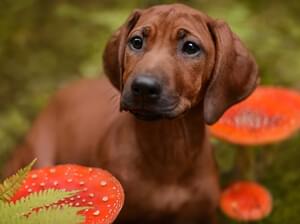 Fungi
FungiDogs and blue-green algae poisoning
Beware of lakes, ponds and waterways discoloured by blue-green algae. This is actually a type of bacteria, which resembles algae when clumped together. Blue-green algae may appear as a greenish scum or foam, green flakes, or swirls of green or blue colour in the water.
Don’t let your dog swim in or drink this water – some species of blue-green algae can be very dangerous, or even fatal, to dogs.
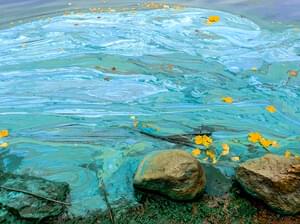 Blue-Green Algae
Blue-Green AlgaeBeach hazards for dogs
If you’re taking your dog for a seaside stroll this season, always keep a close eye on what he’s up to (and not just because of cliffs and strong currents).
Lapping up seawater could make your dog very sick – be sure to bring enough fresh water along for him to drink. And rinse his paws with it when heading home, to prevent salt irritation.
Dried seaweed can swell up in a dog’s stomach if eaten, causing blockages (ditto accidentally swallowing a lot of sand).
Sadly, there have been rare reports of dogs dying after eating dead fish, starfish or crabs on beaches. Be aware too that jellyfish can still sting even when washed up on the shore.
Palm oil fatbergs are floating lumps of congealed palm oil that sometimes wash up on beaches, where their oily smell attracts canine curiosity. While palm oil itself isn’t poisonous, when mixed with pollution and bacteria it can become a stomach-turning mouthful – and lumps can be dangerous if they become lodged in your dog’s throat.
Signs of dog poisoning
If your dog shows any signs of poisoning after a walk – such as excessive drooling, vomiting, diarrhoea, shakiness, breathing problems, lethargy or seizures – contact your vet.
To find out about more common hazards, watch our guide to things dogs can’t eat.